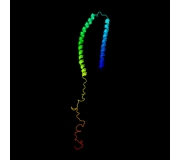HUMAN ALPHA SYNUCLEIN SNCA ELISA KIT (α-synuclein, alpha-synuclein, alpha-synuclein, 27740)
 Click to enlarge |
|
Human Alpha Synuclein (SNCA) ELISA Kit (96T)
This colorimetric selective and sensitive ELISA kit for human α-Synuclein has an assay range of 0.16 – 10.00ng/mL. It has negligible cross-reactivity with human β-Synuclein and human γ-Synuclein. The kit can be used to detect alpha-synuclein in serum, plasma, CSF and cell culture supernatant. 96T
Highlights:
- Complete Sandwich ELISA kit in strip plate format. Colorimetric reading at 450nm.
- ELISA plate is pre-coated with anti- human SNCA (3G11) monoclonal antibody.
- Detects human Alpha-Synuclein in nomal human serum, EDTA plasma samples, and normal human CSF samples.
- EIA buffer contains 1% BSA, 0.05% Tween 20 in PBS
- Incubation times: sample with plate: overnight. With detection antibody: 30 minutes – 1 hour
-
Assay range: 0.16 – 10.00ng/mL.

-
Equilibrate plate to RT
-
Add sample to plate, incubate overnight
-
Add detection antibody, incubate 1 hr
-
Add color reagents, 30 min
-
Add stop solution. Measure OD at 450nm
Background on Alpha Synuclein:
Alpha-Synuclein is a soluble protein that is likely involved in the signal regulatory system of synapctic vesicles. The protein is 14.5kDa, 140 Amino Acids long, and is mainly found in the presynaptic terminals and nucleus of cerebral neocortex, hippocampus, nigra, thalamus, and metepencephalonl neuron cells. This ELISA kit can be used to quantitatively measure the concentration of Alpha-Synuclein in human blood or human CSF.
Alpha-Synuclein is the main structural component of Lewy Bodies, inclusions inside neurons which when present in high concentrations characterize neurodegenerative diseases such as Parkinson’s disease, dementia, multiple system atrophy and synucleinopathic neurodenerative diseases since they induce dopamine-producing cells to shed.
Validation Data:

References:
- Ulmer TS, Bax A, Cole NB, Nussbaum RL (Mar 2005). “Structure and dynamics of micelle-bound human alpha-synuclein”. J Biol Chem 280 (10): 9595-9603.
- Alim MA, Hossain MS, Arima K, Takeda K, Izumiyama Y, Nakamura M, Kaji H, Shinoda T, Hisanaga S, Ueda K. (Jan 2002). “Tubulin seeds alpha-synucleinfibril formation.”. J. Biol. Chem. 277 (3): 2112-2117.
- Iwai A, Masliah E, Yoshimoto M, Ge N, Flanagan L, de Silva HA, Kittel A, Saitoh T (February 1995). “The precursor protein of non-A beta component of Alzheimer's disease amyloid is a presynaptic protein of the central nervous system”. Neuron 14 (2): 467-475.
- Bartels T, Choi JG, Selkoe DJ (August 2011). “a-Synuclein occurs physiologically as a helically folded tetramer that resists aggregation”. Nature 477 (7362).
- Okochi M, Walter J, Koyama A, Nakajo S, Baba M, Iwatsubo T, Meijer L, Kahle PJ, Haass C (Jan 2000). “Constitutive phosphorylation of the Parkinson's disease associated alpha-synuclein” (free full text). J Biol Chem 275 (1): 390-397.
- Tokuda T, Salem SA, Allsop D, Mizuno T, Nakagawa M, Qureshi MM, Locascio JJ, Schlossmacher MG, El-Agnaf OM.”Decreased alpha-synuclein in cerebrospinal fluid of aged individuals and subjects with Parkinson's disease.”Biochem Biophys Res Commun. 2006 Oct 13;349(1): 162-6. Epub2006 Aug 14.
Storage: 4°C, 1 year
Safety: Stop solution contains acid. Avoid contact, wear eye protection.
Shipping: Overnight delivery to continental United States addresses. International delivery is also available: Please inquire for costs.
 Products
Products Manuals
Manuals




